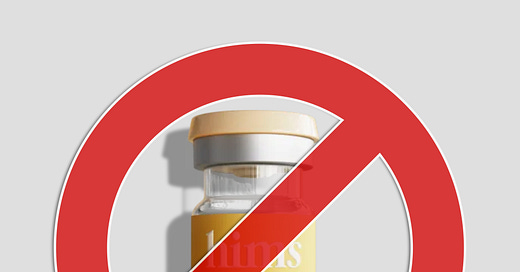Compounded GLP-1 Medications May Soon Be a Thing of The Past
How FDA’s recent announcement is causing major headaches for makers of compounded GLP-1 products.
Well, that didn’t take long. Just a little over a week since I posted my last article on the subject, FDA announced that “the shortage of semaglutide (i.e., Wegovy and Ozempic) has been resolved and now meets or exceeds both current and projected US demands”. They stated that they will give compounders a 60 to 90-day grace period to discontinue making and marketing their versions of semaglutide in order “to avoid unnecessary disruption to patient treatment and to help facilitate an orderly transition”.
As a result the Hims & Hers CEO said during an investor call this week that the company will need to stop selling compounded semaglutide injections, causing the company’s stock price to fall nearly 22%.
While this is a major victory for Novo Nordisk, manufacturer of Wegovy and Ozempic, the battle to end the compounding of these products isn’t over just yet. Earlier this week a group of compounding pharmacies sued FDA, claiming that they made a “reckless and arbitrary decision” to call an end to the shortage. They state that there has not been sufficient evidence provided to indicate adequate supply of these products and that FDA is essentially caving to pressures from Big Pharma.
This looks to be a pretty common tactic as a similar situation occurred last year with Eli Lilly’s tirzepatide, manufactured under the names Mounjaro for the treatment of diabetes and Zepbound for the treatment of obesity. Tirzepatide landed on the FDA shortage list in December of 2022. As with semaglutide, compounding pharmacies were quick to take advantage of the situation and began marketing their own versions.
FDA declared the tirzepatide shortage was resolved in October of 2024, but they were sued by these same organizations claiming the decision was “unlawful“. As a result FDA paused the end of the shortage and announced it was reconsidering its position. Then, in December of 2024 they issued their final decision stating that the shortage was, in fact, resolved. Tirzepatide remains off of the shortage list to this day. I imagine we will see something similar play out with semaglutide, and this lawsuit will not have much of an impact on FDA’s decision.
In the meantime, companies like Hims & Hers must make a hard pivot from their current practices by assisting their customers with the transition away from compounded semaglutide to branded GLP-1 products or other agents they market for weight loss such as bupropion, metformin, topiramate, vitamin B12, and naltrexone. That said, I am not convinced we will ever see a real end to this spectacle.
The weight loss market has no signs of slowing down, with some reports suggesting there are nearly 160 obesity drugs currently in development by big pharma companies. With so much innovation and an insatiable appetite for these types of therapies, consumers will continue to seek out more unconventional means to acquire them at a price they can afford.
And you’d better believe Pharma is paying attention. We are starting to see unique moves being made to help patients access these medications in a more cost effective way. In August of last year Lilly began offering single-dose vials of Zepbound as opposed to the auto-injector pen. This serves a few purposes.
First, it helps further mitigate additional compounded products from hitting the market. One argument compounders have made to defend their ability to make copy-cat products is that they are providing unique dosage forms (i.e., single-dose vials for self-administration vs. auto-injector pens). With Lilly now manufacturing a variety of different strengths of single-dose vials of Zepbound it makes a much harder case for compounders to continue marketing their own versions.
The second (and in my opinion more important) purpose of offering this additional product line is that it allows Lilly to offer them at a substantial discount. The cost of the vials ranges from $349 to $499 per month depending on the strength, compared to a little over $1,000 per month for the auto-injector pen.
Time will tell how well these products do in the market place, but I’d be willing to bet companies like Novo Nordisk are watching closely to see whether or not they should follow suit. Regardless, it has been very interesting to see how Pharma has adapted to increases in competition. I look forward to grabbing a big bowl of popcorn and watching along as the market reacts. Very exciting times ahead.




